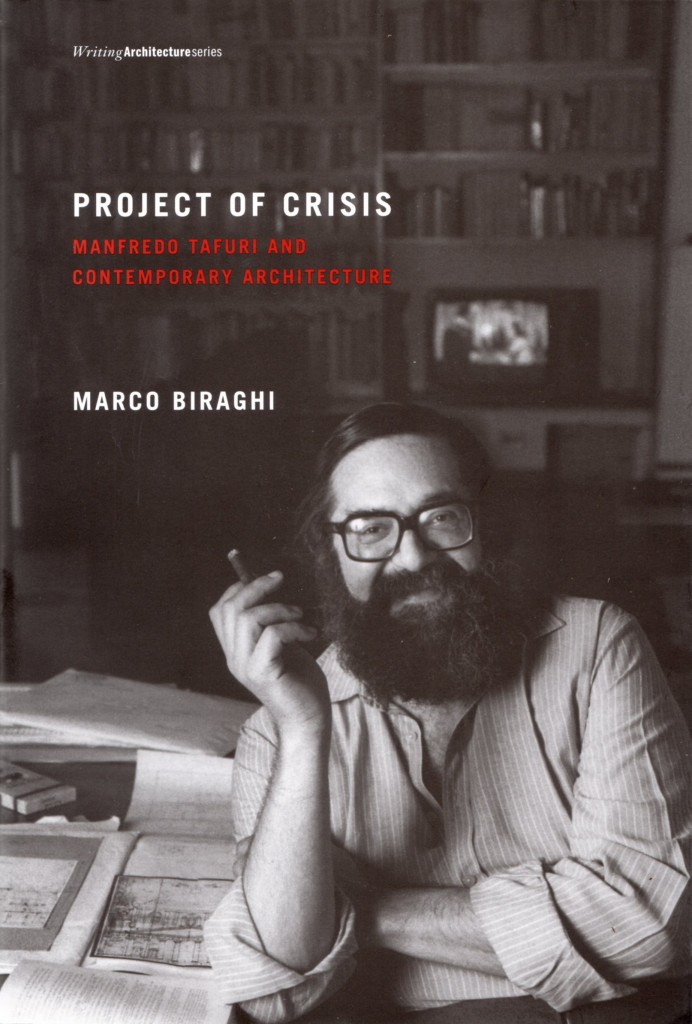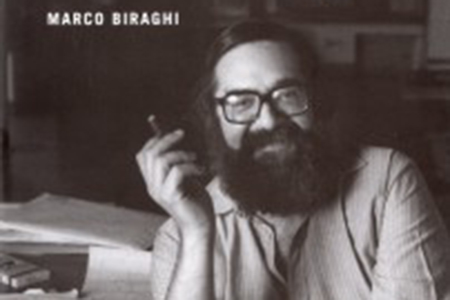
Marco Biraghi
Project of Crisis
Manfredo Tafuri and Contemporary Architecture
The MIT Press
Cambridge, Mass. 2013
Preface
The subject of this volume is the “project of crisis,” or progetto di crisi, of the architectural historian Manfredo Tafuri (Rome, 1935-Venice, 1994). Progetto di crisi is a quintessentially Tafurian term that can assume many different, nuanced meanings. Progetto, often translated as design, is more broadly used in Italian, and can mean project, plan, and even architecture. It can also imply a projection or an intention. Hence progetto di crisi cannot be literally translated, but alludes to the productive possibilities of crisis. It is a condition, but also a chance. This multiplicity of meanings also allows me to make an immediate disclaimer here: I have no pretense of painting an exhaustive picture of Tafuri’s world, nor do I intend to confront the intellectual biography of one of the most complex and influential figures of the late twentieth century.1
Anyone who knows Tafuri from having read his numerous books or listened to his university lectures understands that his interests ranged from the Renaissance to the years in which he lived, and that he did not limit himself to architecture alone but included all that constitutes architecture’s inseparable (though too often de facto separate) context and foundation-its lifeblood of society, the economy, culture, and the thinking of the time. More than the work of other historians, and despite his involvement in a variety of subjects and periods, Tafuri’s work possesses a coherence, supported and illuminated by a lucid line of thinking. Accordingly, there is no contradiction between Tafuri the Renaissance historian and Tafuri the contemporary critic, only the greatest possible integration between the two. As I will try to demonstrate, a common thread motivates both facets, and the subdivision between historian and critic becomes, in any case, beside the point.
Rereading Tafuri’s historiographic definition of contemporary architecture is in no way equivalent to reducing his work to this period alone-his work cannot be conveniently divided into separate fields, self-sufficient and distinguished by their independent logic-nor is it the equivalent of acritically confusing these fields with one another; nor does it mean to deprive each of its own specificity. Rather, rereading Tafuri means circumscribing the field of inquiry to only one part of a vaster terrain-one that nevertheless contains the many problems (or at least a good number of them) with which Tafuri dealt from the early 1960s until his untimely death in 1994. It also means moving on to a historicization of his writing on the contemporary period, in search of evolutions, second thoughts, and fertile contradictions interlaced throughout-in search of more or other Tafuris within Tafuri.
Trying to focus on the crucial points, on the critical and the more productive moments of his specific historical construction of contemporary architecture-his progetto di crisi-is not to be understood as a demanding piece of historical bravura on a problematic period by a notoriously difficult author. I have no intention of creating any sort of short guide to Tafuri’s thinking. The best explanations of his thought remain his own work-which I can only strongly suggest be read.
Rather, the inspiration for this book is something else entirely. To propose today an analysis of Tafuri’s interpretation of contemporary architecture is to suggest some value beyond mere academic or historiographic interest. After all, to embark on such a weighty endeavor, so fraught with peril, would be senseless unless there were some sort of urgency. My deeply rooted conviction is that something within that project of crisis speaks to the present, without in any way rendering it banally current. For this reason, I aim to relate this project of crisis to what, in many ways, seems to descend from it. My conviction is that Tafuri’s project of crisis, in the chronological terms specified here, is fundamentally important in understanding the present-day architectural condition.
I must extend my heartfelt thanks to many people for the counsel they so generously provided during the many years I worked on what is here reduced to a rather inconspicuous little volume. That I do not list specific names should in no way be read as unwarranted ingratitude, but rather reflects a more specific desire to avoid any errors in reception on my part.
I would thank Cynthia Davidson for her strong faith in this book, and her editorial team, Tina Di Carlo, Taylor Davey, and Luke Studebaker. I also thank Alta Price for her dedication to translating this book from the Italian. Because the existing English translations of Tafuri’s work are notoriously inconsistent in quality, she has translated anew the quotations from his Italian texts unless otherwise noted.
1. A comprehensive study of Tafuri is still lacking nearly twenty years after his death. Interesting biographical notes can be found in the special monographic issue of Casabella dedicated to Tafuri. In particular, see Giorgio Ciucci, “Gli anni della formazione” [The Formative Years], Casabella 59, no. 619-620 (January-February 1995): 12-24. An evaluation of his legacy from an entirely contemporary viewpoint is attempted (albeit with notable biases and blind spots) in a monographic issue of Any magazine. See Ignasi de Solà-Morales, “Being Manfredo Tafuri,” Any 25-26 (February 2000): 10-70. For a historico-critical approach to Tafuri, see Daniel Sherer, “Progetto e ricerca: Manfredo Tafuri come storico e come critico,” Zodiac 15 (March-August 1996): 32-51. See also Daniel Sherer, “Tafuri’s Renaissance: Architecture, Representation, Transgression,” Assemblage 28 (December 1995): 34-45. An interesting study published after the release of the Italian edition of my book is that of Andrew Leach, Manfredo Tafuri: Choosing History (Ghent: A&S Books, 2007). The chapter on Tafuri in Anthony Vidler, Histories of the Immediate Present: Inventing Architectural Modernism (Cambridge, MA: MIT Press, 2008), must also be noted.
29 agosto 2013
